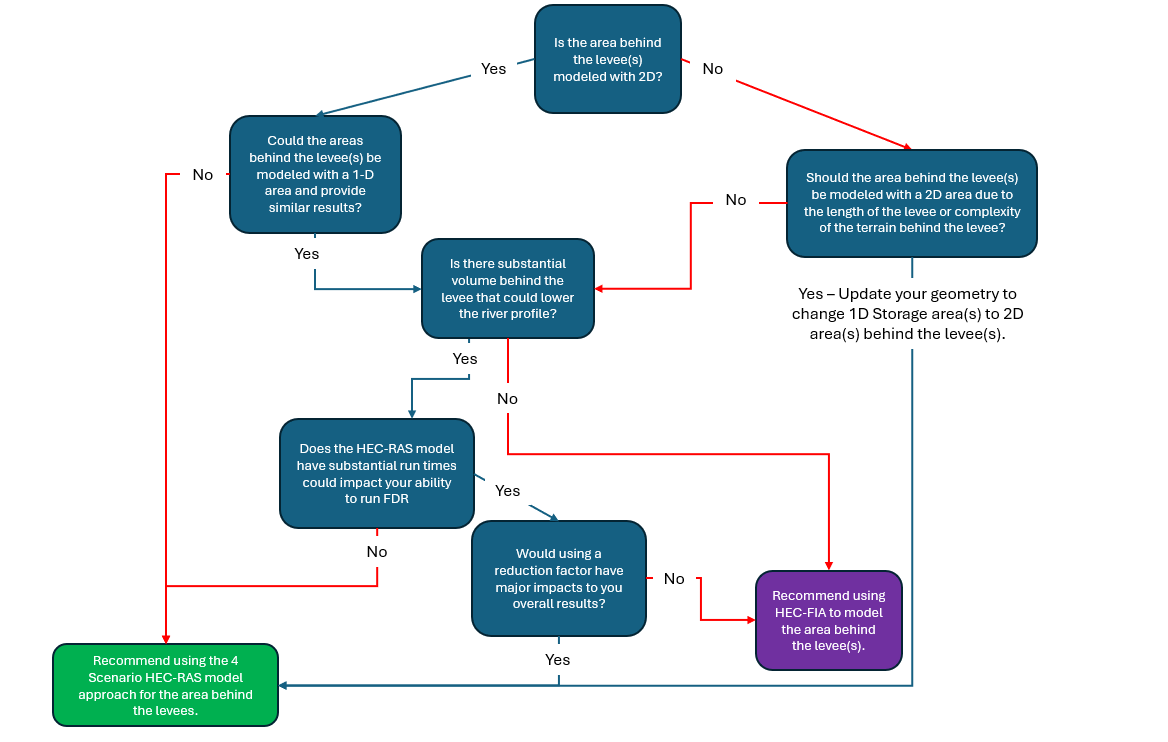Selecting a Without-Levee Modeling Approach
When modeling areas with levees, it's important to decide whether to use HEC-RAS or HEC-FIA for the "without levee" scenario. The flow chart below can help guide this decision for your specific basin.

2D vs. 1D Considerations
Many levees protect relatively small but critical areas that don’t require the complexity of a 2D model. In such cases, using a 1D storage area (with level pool routing) may be appropriate. If you use a 1D storage model for the protected area, the HEC-FIA reduction factor approach might be the best option. This method can greatly reduce simulation time by only requiring two RAS plans to get the results.
Some large, complex levee systems in the USACE portfolio cannot be accurately represented with level pool routing (i.e., 1D. These systems often protect vast areas and require a more detailed model. A shorter levee system might have consistent river profiles, making it suitable for HEC-FIA with a reduction factor. However, longer levees might be affected by tributaries or backwater effects that a 1D model can’t capture. In these cases, it’s worth considering the effort to build "no levee" geometries in HEC-RAS and running the four scenarios.
Volume Considerations
Understanding how the absence of the levee would impact river stage is crucial. In many cases, small levees only slightly affect river stage. For these situations, HEC-FIA is a good choice. If the removal of the levee causes only a small decrease in river stage, a reduction factor can be applied to account for this. Without such a factor, the estimated damages could be higher than expected. It's important to note that the HEC-FIA reduction factor applies only to the area behind the levee, but uses water surface elevations from the "with levee" scenario.
There’s no standard reduction factor that works for every case—it depends on the specific characteristics of the levee and the protected area. As indicated in the flow chart, you’ll need to balance the accuracy of the results with your ability to run FDR using CWMS.
Reduction Factor Examples
Isolated Levee
Imagine a scenario where removing the levee causes a 10% reduction in water surface elevation, but only the community behind the levee is at risk of flooding. The nearest other affected areas are 10 miles upstream and 15 miles downstream, and the reduction in river stage is negligible for those areas. In this case, using HEC-FIA with a reduction factor of 0.9 would provide accurate results for the community behind the levee and surrounding areas. It would also save significant time, as you’d only need to run two HEC-RAS scenarios, reducing future model maintenance.
Levee with Nearby Communities
Now consider a situation where removing the levee also causes a 10% reduction in river stage, but there’s another community on the opposite side of the river, located on higher ground. This community is at risk of flooding during large events, and substantial agriculture exists near the floodplain. In this case, using the HEC-FIA reduction factor might not fully account for the impact on surrounding areas. The damages might be overestimated behind the levee, and underreported for the community and agriculture on the other side. Running a separate "without levee" scenario in HEC-RAS could be a better approach here, provided running the four HEC-RAS scenarios doesn’t hinder FDR analysis using CWMS.